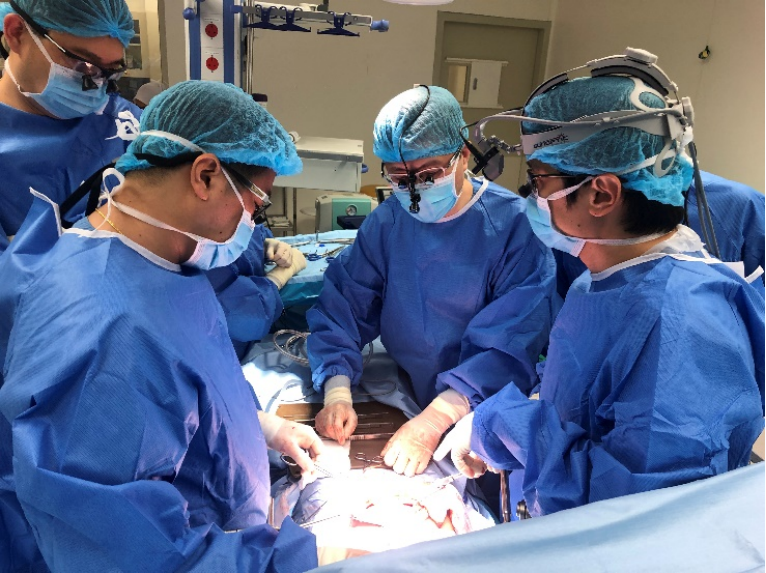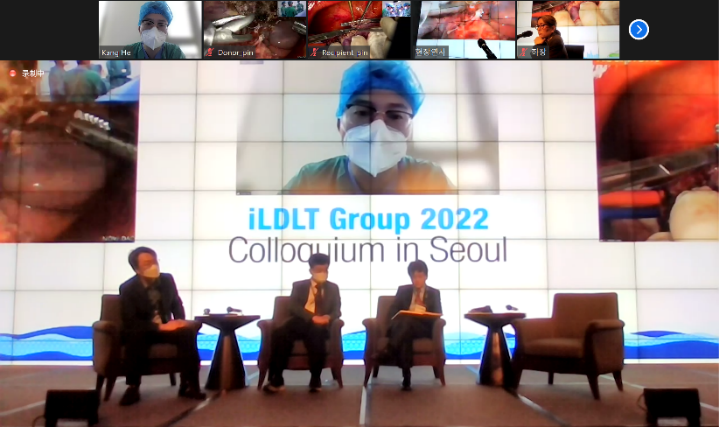On 22 Nov 2023, China announced the list of newly elected academicians of Chinese Academy of Engineering and Chinese Academy of Sciences. Prof. Xia Qiang, President of Renji Hospital affiliated with Shanghai Jiao Tong University School of Medicine was elected academician of Chinese Academy of Engineering. The team under his leadership started from scratch and built a world’s top academic discipline. So far, more than 7,000 cases of liver transplantation have been completed, including over 3,000 cases of liver transplant for children.The 1-year and 5-year survival rate after liver transplant in children can reach 95% and 94% respectively.
Starting pediatric liver transplantation from scratch
In 1999, Xia Qiang chose the emerging minimally invasive laparoscopic surgery as his mainresearch focus. While working and studying at Graz University in Austria as a senior visiting scholar, he witnessed the whole process of liver transplant surgery for the first time. It was at that time when he had a strong urge in his heart: "When can I also master this cutting-edge medical skill?"
At that time, it was not possible to carry out routine liver transplantation in China, and there was no direct clinical experience. Even in Austria there were only a dozen operations a year. After returning to China in 2000, Xia Qiang joined the liver transplant team of Shanghai General Hospital. By 2004, he had completed more than 100 liver transplant operations and won the Shanghai Clinical Medical Achievement Award.
In September 2004, 38-year-old Xia Qiang was recruited by Renji Hospital as a special talent. He formed a young team with an average age of 32. With just a dozen beds at first, the team successfully completed four liver transplants in the first week, which was a morale boost for the entire hospital. Within a year, Xia Qiang led the team to make more than 120 liver transplants, making liver transplantation a strength of Renji Hospital.

Liver transplantation is one of the most difficult operations in surgery. Xia Qiang once described it as "operating on tofu." In the first few years of his career, Xia Qiang spent all his time and energy on surgery and patients, as if they were his entire world. He spent many nights in the hospital, often staying outside the ICU to monitor patients' recovery after surgery.
In 2006, as the number of annual operations increased, Xia Qiang keenly anticipated that the limited liver resources would increasingly restrict the development of liver transplantation. That’s why he had the idea of using livingdonor organ transplantation to break the bottleneck of liver shortage.Xia Qiang led his team to cautiously explore living donor liver transplantation (LDLT). As their technology gradually matured, he set a new goal in his mind - to carry out living-related liver transplantationfor children.
At that time, children's liver transplantation was rarely carried out in China, let alone in Renji Hospital. But what Xia Qiang was trying to do was to innovate from this blank sheet and make it the best in China and even the world. The difficulties to navigate a whole new field is beyond imagination. Mr. Xia's ambitions were also met with skepticism in the industry: are there many children in need of liver transplants? Are parents willing to donate liver? High risk, difficult technique, expensive surgery...
But Xia Qiang firmly believes that living-related liver transplantationfor children can save lives. Despite its difficulty, this technology will be acknowledged by parents and the industry in the future.
Every year, 3000-5000 children in China suffer from end-stage cirrhosis due to various congenital diseases. Before the existence of mature liver transplant operations, in 90% of such cases, the sick child dies before the age of 1. Liver transplantation is the most effective means to save children with end-stage liver disease.
The difficulty of LDLT in children is not only that the organs and blood vessels of the children are very small, but also that most of these children have other organ abnormalities, meaning that liver transplant is not the only challenge faced by doctors in the operation.
In 2006, a 9-month-old child became the first child to receive a living donor liver transplant at Renji Hospital, with the child’s mother donating part of her liver. After a 13-hour operation, the child was successfully saved. By 2009, Xia Qiang's team ranked first in Shanghai in terms of the number of annual LDLT operations for children. In 2011 they became No.1 in the world.
For more than a decade, thousands of children were brought in front of Xia Qiang. They were not blessed by fate when they were born, yet they were saved by persistence andbenevolence. Every year, children who have grown up healthily after successful liver transplant would return to Renji Hospital. A fatherly smile always appears on Xia Qiang’s face whenever he sees these healthy and lively children, as if he was not a doctor, but a member of the child's family.
Establishing the operation standard and postoperative management system of pediatric liver transplantation
More responsibilities have been put on Xia Qiang’s shoulder since he became president of Renji Hospital, but he still performs about 100 pediatric liver transplants a year. He manages to do so by scheduling surgeries on Saturdays and Sundays, when there is less administrative work. He holds the record for being the earliest to arrive in the administration building. Whenever someone arrives earlier than him, it would become the headline of the day. Xia Qiang also reserves half a day to see outpatients each week, while his evening time is reserved for lab and students.
In Xia Qiang, you will find the perfect balance betweenprecision and decisiveness. Over the years, he has designed multiple treatment plans for patients, always fully prepared for each step before surgery... These habits are not only Xia Qiang's personal persistence, but also have become the tradition of the team.
A liver transplantation is a life-or-death procedure.There are three sets of blood vessel system and one bile duct system in the liver. Thediameter of the thinnest adult blood vessel is only two or three millimeters, and that of the blood vessel in children is only 1 millimeter. Under 2.5 times or 8 times microscope, 12 stitches are required, with speed and precision.

During surgery, the patients will experience one hour without liver, which greatly affects the heart and the entire circulation. Once the blood vessels of the transplanted liver are sewn up, the returned blood of the lower body immediately "whoosh" into the liver. One single stitch not tight enough could lead to the failure of the entire operation.
There was one child with biliary atresia weighing less than five kilograms. The diameter of his portal vein, the main blood vessel in the liver, was less than 30% of that of the normal blood vessel due to abnormal development, which means the transplanted liver would not function properly due to poor blood supply, resulting in the death of the child. Xia Qiang designed a variety of plans, and finally decided to cut the main blood vessel and obtain autogenous blood vessels from the diseased liver aspatch materials for reconstruction to make it thicker. The method of portal vein reconstruction was the first in the world. With his superb technique, he succeeded in saving the child’s life.
It is through the pursuit of precision and perfection in each operation that Xia Qiang has developed outstanding medical skills, making his team one of the best in the world in pediatric liver transplantation.
In 2015, Professor Xia Qiang was elected as the chairman of the Pediatric Organ Transplant Professional Committee of the Organ Transplant Physicians Branch of the Chinese Medical Doctor Association. In order to promote pediatric liver transplantation technology, standardize the diagnosis and treatment behavior of pediatric liver transplantation in China, and provide reference for medical institutions that are or will carry out pediatric liver transplantation, Professor Xia Qiang led the work of writing China's firstClinical diagnosis and Treatment Guide for Pediatric Liver transplantation (2015 edition), introducing in detail all aspects that should be paid attention to in carrying out pediatric liver transplantation. Before this, there was no regulation to follow for pediatric liver transplantation in China, and many diagnosis and treatment behaviors were based on experience.
Over the years, Xia Qiang’s team has built a national liver transplant physician training base by holding academic conferences and training courses, training more than 2,000 domestic and foreign skilled talents, covering more than 90% of China's hospitals that carry out children's liver transplantation, and helping many hospitals to carry out their first child liver transplant operation.
For children with liver transplantation, successful surgery is only the first step. Long-term immunosuppressive drugs and decades of management and monitoring are also needed for their long-term survival.
The immune system of children is not yet complete, and compared with adults, children are more prone to infection and rejection after liver transplantation. Their immune status must be more closely monitored and more precise medication must be used. However, the use, dosage and efficacy monitoring of immunosuppressants after liver transplantation in children all lack corresponding plans and standards.
Xia Qiang's team found in clinical practice that it is not feasible to simply apply the immunosuppressant dosage of adults to children after scaling down, because children are not mini-sized adults, and their metabolism is completely different from that of adults. At the same time, the situation of Chinese children is different from that of foreign children, meaning copying foreign guidelines will not work.
In order to solve these problems, Xia Qiang's team conducted years of intensive research and established a set of postoperative liver transplantation management plans suitable for Chinese children: They were the first in the world to propose the initial dose and blood concentration range of immunosuppressants (tacrolimus and cyclosporine) after liver transplantation in Chinese children; They proposed guidance of individual drug use of immunosuppressants based on CYP3A5 genotyping; They innovatively use ATP concentration of peripheral blood CD4+T cells as a new immune monitoring parameter to establish a set of postoperative immune monitoring standards and decision-making plans suitable for Chinese children, which provided a more powerful guarantee for the accurate use of immunosuppressants and the reduction of postoperative infection and rejection.
Promoting China’s technology to the world
Already being “No.1 in the world” in pediatric liver transplantation, Xia Qiang still wants to achieve more.

In November 2022, the annual academic conference of the International Living Donor Liver Transplantation Society was held in Seoul, South Korea. As the only team invited to live broadcast surgery at the conference, Renji Hospital's Department of Liver Surgery performed fluorescent laparoscopic donor liver resection and pediatric liver transplantation in front of the world's top liver transplant scholars, demonstrating China's LDLT strength to the world.
The 1-year-old boy with congenital biliary atresia received the liver donated by his father. In the past, surgery would leave scars on liver donors, but laparoscopic surgery makes the wound extremely small and hidden while ensuring safety, which is popular among young parents. It has also become a surgical feature of Xia Qiang's team in recent years. The conference reserved a time slot from 8 am to 5 pm for this operation, but the actual operation completed early at 2 pm. With two operations closely coordinated and completed in one go, the total operation time was less than 6 hours, which received unanimous praise and warm response from the experts attending the meeting.
For a long period, the United States used to be the country that carries out the most pediatric liver transplant operations in the world, with 500-600 surgeries annually, while before 2011, China had carried out only about 100 cases of pediatric liver transplant, with less than 60% 1-year survival rate.In 2017, China completed 722 pediatric liver transplants a year, surpassing the United States for the first time. Among them, 400 were completed by Xia Qiang's team.
Xia Qiang's team has also promoted pediatric liver transplantation technology to Southeast Asian countries. About seven or eight years ago, a Malaysian parent of a child with biliary atresia was doing business in China when they accidentally heard that their child could be treated in Shanghai. So, he took his child to receive a liver transplant at Renji Hospital. The child's operation in Renji Hospital was very successful, and it caused a great response in the Malaysian medical community after they returned home. Local doctors examined the child and found that the quality of surgery performed by Shanghai doctors was comparable to that of Singapore and Japan, where local patients had gone before. The cost of a child's surgery in China is only one-fifth of that in Japan. Since then, a total of more than 40 Malaysian children have received LDLT operation at Renji Hospital. In August 2019, Xia Qiang led his team to Malaysia to assist the University of Malaya Medical Center to complete the first child living donor liver transplant.
Never let one child miss a chance
In the early days of Xia Qiang's exploration of children's liver transplantation, with increasing surgery amount and increasingly sophisticated techniques, the long-term survival rate and quality of life of the children after surgery were greatly improved. But in reality, families with sick children faced a problem: money.

"We analyzed the families of the first 200 children who went to Renji Hospital for treatment, 100 of these children chose surgery, and the other half gave up surgery, and the number one reason for giving up surgery was financial problems." At first, when there was family with financial difficulties, Xia Qiang would mobilize the medical staff in his department to donate money from their own pockets. As their social influence expands, many people in society took the initiative to contact Xia Qiang and donated money to poor children's families. Since then, Xia Qiang's team has worked with charities large and small to raise money for the treatment of poor children's families.
Thestory of love is never ending. The first transplant recipients are now in their teens. Xia Qiang’s wish for them is that they will be healthy and successful and be able to give back to society in the future. One of the children who had liver transplant returned to the hospital to visit Xia Qiang and said he wanted to study medicine in the future. Knowing the child’s ambition, Xia Qiang could not hide his excitement:"I hope that they can study hard. If one of them becomes a liver transplant doctor in the future, the story will have a perfect ending."

